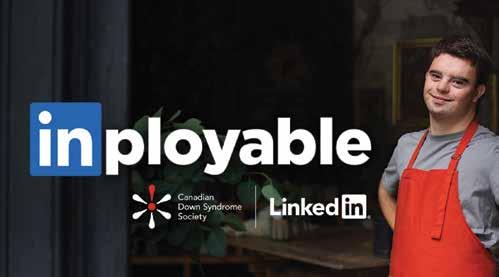
6 minute read
A Glimpse at a More Inclusive Retail Future
Starbucks Korea Gets Inclusive

A pioneering example of universal design can be seen in the inclusive space Starbucks Korea (right) has created for customers and employees with a wide range of abilities. Employees are equipped with digital tablets to facilitate communication with customers. The store floor, back room and bar have all been designed in collaboration with members of the disability community to better optimize the space for using mobility aids. Other features include a dual-monitor POS that shows customers their order, contactless speech-to-text voice recognition through a tablet at the register, Braille menus and tactile signs to navigate the store.
Shopping With Goodmaps
UK supermarket giant Asda implemented new tech last September to make it easier for blind and partially sighted customers to navigate stores. Incorporating the smartphone app GoodMaps, user location
Katie Baron, Content Director, Trends, Stylus, cautions retailers to think about users of all abilities.
is mapped throughout the store and the app can communicate directions to product aisles or store areas via audio, enlarged visuals and touch commands. Shoppers can also search for key landmarks within the store such as the pharmacy, toilets and tills

Spoken Rx
In 2022, US retail corporation CVS launched Spoken RX (below left), the first in-app prescription reader to be developed by a national retail pharmacy. The labels are scanned using the Spoken RX tab in the CVS app and important prescription information is read out loud for the customer, removing barriers to healthcare for all patients.
Comme Deux For You
Danish beauty brand Comme Deux allows online users to adjust their website viewing experience with preference settings to turn on options such as “seizure-safe profile,” “ADHD-friendly profile” and “cognitive disability profile.”
THE NEED FOR “UNIVERSAL BRANDSCAPES”
The next decade will make it a moral and commercial imperative for retailers to service and empower consumers of all abilities (physical, mental and sensory) within the same spaces, both physical and digital, and without silos. We call this “universal brandscapes.”
It’s a liberation missive for every part of the brand ecosystem when you consider that approximately 16% of people globally live with a disability, yet under 1% of primetime TV ads show that reality, and 43% of people with a condition have abandoned purchases online due to poor accessibility.
This response means representation from the adverts we’re served to the virtual worlds where we’ll self-represent. It’ll also mean UX – from specialist filters, overlays and coding recalibrating e-commerce in a nanosecond for conditions as diverse as dyslexia and Parkinson’s, to image-recognizing and multisensory tech retrofitting physical spaces so they can be navigated in a number of ways.
Why is this imperative long-term? As the awareness and diagnoses of neurodiversity rises, we will see a much greater consumer demand for brand initiatives that accommodate a far greater number of personal nuances. Similarly, aging populations and a focus on how retail supports older citizens or those moving through life changes will hit the top of consumers’ agendas.
Community In The Metaverse
We might have seen a cooling off from brands this year as fears of recession and inflationary pressures bite into budgets, but make no mistake, the metaverse (a.k.a. always on, communally accessible, interactive virtual worlds) is the next phase of the internet, and certainly the future of e-commerce. When faced with the promise of ultraimaginative discovery and technologies that make virtual worlds as sensorially extravagant as “real” life, the old school e-commerce “grid” will look more than tired.
To date, most brands have focused predominantly on the gamification for entertainment in these virtual spaces, not yet looking to their capacity for indulging the growing desire for better well-being, learning, solace and self-expression, smaller forms of social media, and the possibilities afforded by co-presence (spending time with someone virtually, wherever they are in geographical terms).
As avatars become as popular as the “real” thing, digital products cement our online personas and virtual homes start to offer expanded opportunities for retailers. Interoperability – the capacity to leap between worlds – will drive adoption, too.
This won’t only affect retailers’ digital spaces, but also retail flagships as they become vital gateways in inviting the curious and/or uninitiated into their Web3 worlds.
A WORLD OF NON-ABUNDANCE
With climate crisis looming ever larger, we are officially in the age of non-abundance. This doesn’t mean that newness won’t matter, but that the next five to 10 years will mean retailers radically reimagine how they instigate that sparking of fresh joy.
Resales will need to become part of every retailer’s agenda – a grand marketplace of the fabulous pre-loved. It’s a consideration most keenly evidenced in fashion so far, but which will spread to every sector. For e-tail, new hassle-free automated reselling tech (using swing tags and apps and even in some instances the instant creation of localized ads) will offer retailers key wins.
Top: Working with leading makeup artists, Clinique launched the “Metaverse More Like Us” campaign to challenge unrealistic beauty standards. Above and right: Legendary Paris fashion destination Galeries Lafayette launched (RE)Store, an entire floor dedicated to second-hand and responsible fashion.



Store environments, too, will be reshaped by service propositions that put circularity front and centre on the shop floor, including swaps shops and borrowing stores (for everything from podcasting kits to furniture). The latter strategy in particular will boom across the next five years, as consumers seek new ways to cut costs.
Helping consumers to help themselves will underpin this shift. For luxury brands this will manifest an uptick in consumers seeking eco-concierges that look beyond the old school prestige of “brand new” to signal their climate conscious values, and to retailers that can demonstrate a commitment to creating abundance from scarcity, focusing on sustainably regenerating resources.
15-MINUTE CITIES AND THIRD SPACES
Mixed-use communities and 15-minute cities that integrate residential, commercial and retail spaces within walking distance will create more vibrant and dynamic retail environments. The pandemic has accelerated this trend impacting the future of retail. Curating retail and the convenience of having shopping and services nearby encourages the residents of these communities to shop locally and more frequently, leading to increased foot traffic and sales.
In addition, 15-minute cities prioritize walkability, biking and public transportation, which further promotes local retail and reduces reliance on cars. This communitybased living will lead to the resurgence of third spaces, like cafés, libraries and community centres, which act and serve as social hubs for residents, particularly as the residential element in these communities tend to be smaller. Furthermore, the emphasis on sustainability and community-building can attract socially conscious consumers that prioritize shopping with environmentally and socially responsible retailers.
Generative Ai And Large Language Models
The question will be whether retailers will have developed their own AI in house, or buy into whatever the evolutions of Bard or OpenAI’s products become. The changes will be momentous, from unheard-of levels of personalization and product recommendation, high-level engagement mapping both online and in store, and the cost savings that can be seen though predictive pricing to supply chain innovations.
Continued Urbanisation
The world’s urban areas will more than double in size by 2030. Two-thirds of all Canadians will live in an urban area. This will fundamentally impact the ability to access physical retail, and change the nature of stores altogether. Already we are seeing stores becoming community hubs, repurposed to provide experiences beyond their standard intent. This trend will have a negative impact on rural populations, at times already underserved and overpriced, as there will be increased supply chain pressures to serve those areas.
Generation Alpha

Gen A is the demographic cohort commencing in 2010. Although still young, they are already shaping the future of retail. They’ve grown up with technology being an integral part of their daily life. These digital natives expect seamless and personalized experiences across all channels. They are passionate about sustainability and social responsibility, which will force retailers to prioritize ethical and environmentally conscious practices.
The Greying Of Retail

In 2022, Statistics Canada reported that 19% of Canada’s population will be age 65 years or older. They forecast continued increase, reaching 23% in 2030 – that’s nearly one in four of all Canadians. This will impact everything from store design and navigation, lighting, e-commerce UX and product assortment and innovation. Canadian seniors historically have a larger net worth and spending power, and retail will need to keep up to keep whole.
Right: Petco says its pilot recycling program could divert nearly 864,000 pounds of plastic waste from landfill.
Below: Author Paco Underhill sees retail shifting to become far more convenient.
Bottom Right: Vision Greens recently raised $7 million in growth capital to expand operations.









